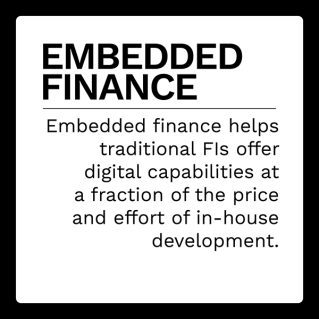Embedded Finance Puts Banks, FinTechs on Equal Footing

Digital services became table stakes for financial institutions (FIs) of all types when the pandemic shut down thousands of physical branches and forced countless more to reduce hours. The added convenience of banking from home or on the go has made digital services the predominant way most Americans interact with their primary FIs, with a recent study finding that 78% of Americans prefer to bank on mobile apps or websites instead of visiting branches in person.
This shift to digital has presented a golden opportunity for FinTechs to disrupt the financial field, much to the chagrin of traditional banks and credit unions. A recent survey found that 70% of FI CEOs consider FinTechs their top competitors, with another study finding that 75% of consumers are drawn to FinTechs’ cost-effective and seamless services.
Regaining this competitive edge will involve a serious effort to implement embedded finance solutions into banking systems, and many banks are already well on their way. PYMNTS’ research found that 92% of FIs are currently innovating or have plans to innovate embedded finance experiences to improve their digital suites, with the most common improvements being seen in loans and cash flow management.
In the latest “Embedded Finance Tracker®,” PYMNTS explores the current state of the financial field and how FinTechs are quickly gaining market share, how embedded finance solutions can help banks and CUs offer new digital services and how these FIs are partnering with FinTechs to make embedded finance a reality.
Around the Embedded Finance Space
 Banks are innovating quickly in response to challenges from FinTechs and other newcomers to the financial scene. One step many banks are taking is migrating their mainframe workloads to the cloud, which 82% of banks report is in their plans for the near future. Most of these banks plan to make this migration within the next two to five years. Many banks already have their customer-facing systems on the cloud but still rely on physical mainframe technology for back-of-house procedures.
Banks are innovating quickly in response to challenges from FinTechs and other newcomers to the financial scene. One step many banks are taking is migrating their mainframe workloads to the cloud, which 82% of banks report is in their plans for the near future. Most of these banks plan to make this migration within the next two to five years. Many banks already have their customer-facing systems on the cloud but still rely on physical mainframe technology for back-of-house procedures.
While banks might talk a big game about moving their infrastructure to the cloud, most have not yet put their words into action. A recent study found that just one-third of banks have migrated more than 30% of their applications to the cloud, but many more plan to in the future. Sixty percent of banks in North America plan to increase their cloud investments in the next three years, along with 83% of banks in the Asia-Pacific region and 82% of banks in Europe, the Middle East and Africa.
For more on these and other stories, visit the Tracker’s News & Trends.
Brex on Deploying Embedded Finance to Compete With FinTechs
The ongoing pandemic has permanently altered the way many consumers interact with their banks, adopting digital services in record numbers to replace in-branch visits. This shift has put traditional FIs on the back foot, but new embedded finance solutions can help them compete.
In this month’s Feature Story, PYMNTS talked with Michael Tannenbaum, chief operating officer of spend management solutions company Brex, about why outsourcing digital work to a third-party embedded finance provider means a vastly reduced workload for existing IT staff and legacy systems.
How Embedded Finance Can Help Level the Playing Field Between Banks and FinTechs
A recent study found that 78% of Americans prefer to bank via mobile app or website rather than visiting branches in person, thanks to the added convenience of being able to bank from anywhere. This digital push has opened the door for FinTechs, challenger banks and digital-native FIs to disrupt the industry as bank customers question the need for traditional banks.
This month’s PYMNTS Intelligence examines why banks are concerned about FinTechs’ upheaval of the financial industry and how embedded finance can help FIs catch up to their younger digital cousins.
About the Tracker
This month’s “Embedded Finance Tracker®,” a PYMNTS and Galileo collaboration, explores the latest in the world of embedded finance, including how embedded finance solutions can help banks and CUs offer new digital services and how these FIs are partnering with FinTechs to make embedded finance a reality.
